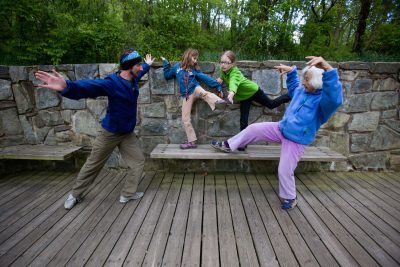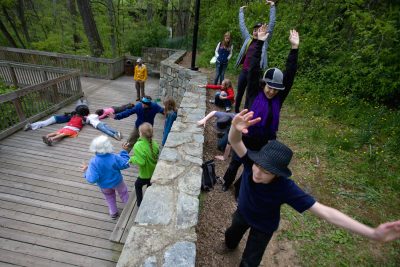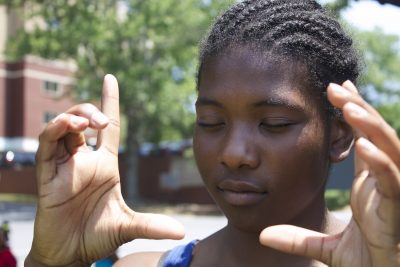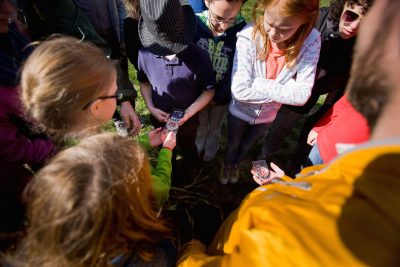The relationship between nature and dance is recognized in our language—rain “dances” on a roof; trees and leaves “twist and turn” in the wind. The legendary dancer and choreographer Martha Graham once said, “The spine is your body’s tree of life. And through it, a dancer communicates.”
Dance Exchange honors the symbiotic relationship of nature and dance with the unique and innovative Moving Field Guide (MFG) program that is offered periodically throughout the year. Those who attend the Takoma Park-based dance company’s Season Kick-Off celebration at the end of this month will be able to sample the experience.

Cassie Meador, Dance Exchange’s artistic director and MFG founder, said that the program “offers a new way to see and experience a place…not just with the eyes.” The experience, she added, builds “the capacity to observe with the whole body.” Artists, naturalists and ecologists lead these short, interactive walks as part of a partnership between Dance Exchange and the U.S. Forest Service.
Meador was on a mountainside in the Appalachian highlands of North Carolina when she shared her insights with CultureSpotMC.com. Locations like that one serve as satellite “offices” for Meador, who travels the country to conduct experiences that marry dance with nature. Her artistic and personal resolve is to “bring us closer to the resources we come from.”
Growing up “in a family of scientists definitely played a role” in the MFG concept, Meador said. She spent her youth in Georgia and earned a bachelor of fine arts degree in dance at Ohio State University. Soon afterwards, she moved to the D.C. area to work with Dance Exchange.
Meador conceived of MFG in 2012 during a 500-mile walk from Takoma Park, where she lived, to Kayford Mountain in West Virginia, where the resources that powered her home “lived.” The journey was part of another Dance Exchange project titled “How to Lose a Mountain.” This two-month quest was pivotal for Meador. It led her to a once beautiful mountain range that had been blown apart to reap the coal inside.

For a time, Meador also lived in Guyana–almost entirely outdoors, while co-teaching a class on tropical ecology at Wesleyan University.
Both expeditions brought to her the realization that our dependency on nature needs to be restored rather than continuously taken. “What I’m seeing is a disconnect,” said Meador, who began MFG because of her travels.
“We are distancing ourselves from where our resources come from,” said Meador who aims to “build awareness to create more of a sense of responsibility.” This is the thesis statement that brought the U.S. Forest Service on board as a partner that provided funding to develop a toolkit for young people and then started seeding the program in Baltimore.
In addition to support from the U.S. Forest Service, the MFG program is made possible by the National Endowment for the Arts, MetLife Foundation, the Takoma Foundation and the City of Takoma Park.
Mark Twery is a Research Forester for the U.S. Forest Service and Lead Project Partner. MFG, he said, “involves bringing together a group of naturalists with dancers and a bunch of students or members of the public to take a nature walk and involve the whole body in learning about nature. The dancers pick up on the gestures the naturalist or students make or we talk about the history of place … and build a dance.”

“Today,” said Meador, MFG “lives as more of a singular engagement in places where environmental programs are already happening. Some of these lead to longer-term repeat engagements,” like the camps and local collaborations through Dance Exchange.
“We are also doing trainings to turn and train educators so they can bring the practices into their work. There is a curriculum and a teacher training for grade three through five teachers across the country,” she added.
“The Moving Field Guides are for all ages. We have facilitated them for adults, youth, and many are for whole families,” said Alison Waldman, Dance Exchange’s marketing and communications manager. Past and present participants include: Girl Scouts of the USA, Wesleyan University, U.S. Botanical Gardens, Glen Echo Park, Arizona State University and elementary schools throughout the greater D.C. region.”
“The Dance Exchange will offer a few weeks of MFG camp for ages 6 to10 both in Takoma Park and at Brookside Gardens during this school year. The camp dates coincide with MCPS spring break and summer,” Waldman continued. “We will also partner with nature centers, community gardens, schools, etcetera.”
The Dance Exchange has a 40-year legacy of national and international work exploring the intersection of art and science and is celebrating its 20th year in operation in Montgomery County. Meador called Dance Exchange “a kind of incubator for this artistic intersection.” It also makes Dance Exchange an irresistible place for Meador to create her own art.

Asked how it feels to dance outside versus inside, Meador said, “Dancing outside is a reminder about how we need to be near the elements–not only what is visible, but also the history and the site that is ‘in process.’”
The juxtaposition of Meador’s workplace–on a mountainside rehearsing a solar eclipse-related dance–and the nature-barren desk and computer many of us call an office stood out during the interview. A bit jealous, perhaps, we had to ask: “Any plans for a similar project that unites dance and technology?”
“It’s actually something we discuss at Dance Exchange,” she responded. “Connecting with technology is another form of directly engaging with our place and our world.”
There’s much more to look forward to from Dance Exchange.
A Season Kick-Off and Moving Field Guide Experience is set for 6 to 8 p.m. Thursday, August 31 at Dance Exchange, 7117 Maple Ave., Takoma Park. Admission is free. Visit http://danceexchange.org or call 301-270-6700. View this event on CultureSpotMC here,